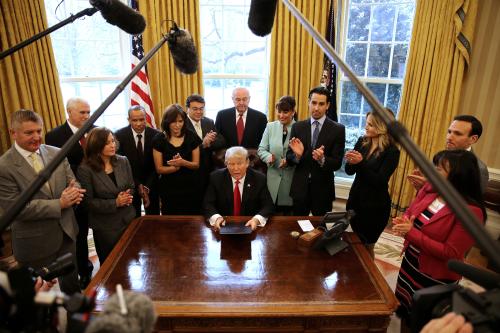While policymakers and news headlines focus on debates about health care and tax policy, the U.S. fiscal outlook remains troubling and is a constraint against which new proposals should be judged. Using new projections from the Social Security and Medicare Boards of Trustees and the Congressional Budget Office (CBO), we show that while deficits are manageable in the short run, the debt-GDP ratio is already high relative to historical norms. Our projections show that both deficits and the debt will rise in the future, even under optimistic assumptions. Sustained federal deficits and rising federal debt will crowd out future investment, reduce prospects for economic growth, and impose burdens on future generations.
The 2017 federal budget deficit is now projected to be $693 billion, or 3.6 percent of GDP. The debt-GDP ratio is projected to be 77 percent at the end of the current fiscal year. Under CBO’s current-law projections, the deficit and debt will rise to 5.2 percent and 91 of GDP, respectively, by 2027.
Our projections show that both deficits and the debt will rise in the future, even under optimistic assumptions.
Current-law projections examine the impact of Congress essentially doing nothing over next 10 years (other than raising the debt ceiling and reauthorizing programs). To complement these projections, we provide “current-policy” projections that aim to understand the impact of what might be termed “business-as-usual” assumptions. What constitutes “business as usual” seems particularly uncertain at the present time, given the new Administration and the new Congress. For consistency with prior estimates and in the absence of more appropriate choices, we derive current policy estimates using similar adjustments to current law as we have made in the past. Through 2027, we let defense spending grow with inflation and non-defense discretionary spending grow with inflation and population (rather than following the caps set in previous legislation). Mandatory spending, including Social Security, Medicare, and Medicaid, follows current law through 2027. (Proposals from the Administration and Republicans in Congress would generate higher defense spending and lower domestic spending than our assumptions.) Additionally, we assume that all temporary tax cuts or tax-delay provisions are made permanent. Under these current policy assumptions, the budget deficit would rise to 6.3 percent of GDP in 2027, with the debt-GDP ratio rising to 98 percent.
Beyond 2027, we assume many categories of spending and taxes remain constant at their 2027 shares of GDP, that outlays and receipts for Social Security and Medicare follow the paths laid out by their respective trustees, and that other health spending follows projections made by CBO. Under these assumptions, the debt-GDP ratio would rise to 173 percent by 2047 and to higher levels in subsequent years.
The fiscal gap, as we define it, shows the tax and non-interest spending changes needed to bring the debt-GDP ratio to a specified level in a specified year. For example, we find that to ensure that the debt-GDP ratio in 2047 does not exceed the current level would require a combination of immediate and permanent spending cuts and/or tax increases totaling 3.2 percent of GDP. This represents about a 16 percent cut in spending or a 19 percent increase in tax revenues relative to current levels. To return the debt-GDP ratio in 2047 to 36 percent, its average in the 50 years preceding the Great Recession in 2007-9, would require immediate and permanent spending cuts or tax increases of 4.6 percent of GDP. The longer policymakers wait to institute fiscal adjustments, the larger those adjustments would have to be to reach a given debt-GDP ratio target in a given year. And any additions that new policies make to projected deficits simply increase the size of the required adjustment.
Download the full report here.






